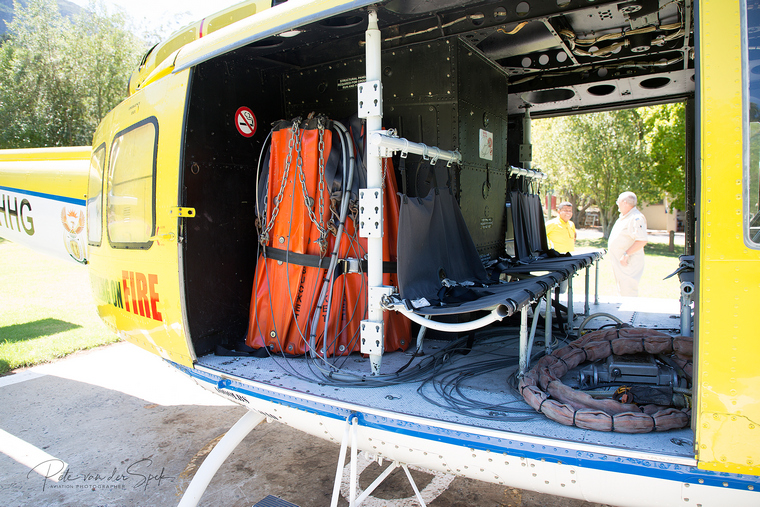



















Working on Fire - Newlands base, Cape Town
By Pete van der Spek
Google Banner Ad
Cape Town and the Western Cape has one of the most diverse fynbos areas in the world. However, come the dry season, that same fynbos becomes a tinderbox. One cigarette butt thrown from a car or dropped by a pedestrian causes a huge problem for fire services in the area.

The fire season in Cape Town and the rest of the Western Cape starts as early as October each year (depending on the conditions). Cape Town is fortunate enough to have an excellent helicopter team who fight fires in the Cape mountains.

I have witnessed the teams' fighting fires near where I live in Noordhoek.
Recently, I visited the helicopter base in Newlands with the beautiful, stunning Table Mountain National Park as the backdrop and met with two of the pilots. I got to hear first-hand how these chaps go about fighting the fires from the air.

Brian Davies and Hugo Barnard aka "Barries" gave me an insight as to how difficult it is flying in sometimes, very difficult conditions.
I asked how they go about deciding where to start once they get to the scene of the fire. I watched them from the ground a few weeks ago fighting a fire in a wetland next to houses, a shopping centre and storage unit in Sunnydale, Noordhoek. The two choppers arrived at the scene before the spotter aircraft and had to decide which area needed to be attacked first. The fire was in the middle of a reed belt and once the reeds start burning, it is apparently pretty difficult to quell the fire. So, wetting the reeds in front of the fire was a good start. Luckily, they had the support of about 15 ground units so they could concentrate on the fire which was heading for houses bordering the fire. Luckily, there is plenty of water close by in the form of Lake Michelle which is apparently a deepish lake, so topping up the baskets is easier than a lake further away which is not as deep. The only way to fill the baskets is to drag them along which is not ideal. Each basket holds 1000 litres of water.


Each fire usually gets a spotter aircraft, which has to come all the way from Stellenbosch airfield, but once above the choppers, the spotter takes over and directs the operation. He has the best view in town to be able to fight the fire. The two chopper pilots then take their instructions from the spotter plane and are usually directed to the hotspots. The turnaround time between drops is roughly 2-3 minutes in this case so they make what is almost a landing every 2-3 minutes which is very intense work. I asked whether heat updraughts are a problem and both pilots said that it is bumpy anyway so the updraughts are not a big problem. Smoke is the bigger problem and they try to avoid flying through the smoke and become unsighted. They thus tend to fly away from the smoke as far as possible.

Barries told me of a story of him fighting a fire (also in Noordhoek) a few years ago during which he lost a basket due to a faulty hook. As he turned to pick up water from the sea, the basket (a brand new one at that) fell into the sea. He has never lived it down it seems. Luckily for the team, the basket washed up on the shore a few days later and the person who found it contacted WOF. It was returned to a relieved Barries.

There are always two pilots on standby at the Newlands base in case of a callout. Brian said that the flying is not your ordinary helicopter flying. It is very intense and not for the faint hearted. They fly alone and have to do all the work themselves - the controls are on the cyclic control and they have to have eyes everywhere.

Recently, a lady in a car lost control and rolled down the mountain along Chapmans Peak drive which caused a fire and the helicopters were called out. The problem was that it was on a slope and the wind was blowing quite strongly. They could only pick up water from the sea, which in itself is difficult depending on the height of the swells. It took a couple of hours to put that fire out and it was fairly close to dusk when they finished.


The company that owns the helicopters is Kishugu Aviation, which has its headquarters in Nelspruit with main branches in Nelspruit, Cape Town, KZN and the Eastern Cape.
Working on Fire operates ground staff as well and they spend their days eradicating alien bush as far as possible. They also fight fires as part of their job. It is an extensive operation and a very necessary operation.

I take my hat off to these guys. Living in among the mountains is really nice and knowing that help in the form of firefighting helicopters close by is very comforting.
Google Banner Ad

 |
 |
 Copyright © 2024 Pilot's Post PTY Ltd
The information, views and opinions by the authors contributing to Pilotís Post are not necessarily those of the editor or other writers at Pilotís Post.
Copyright © 2024 Pilot's Post PTY Ltd
The information, views and opinions by the authors contributing to Pilotís Post are not necessarily those of the editor or other writers at Pilotís Post.